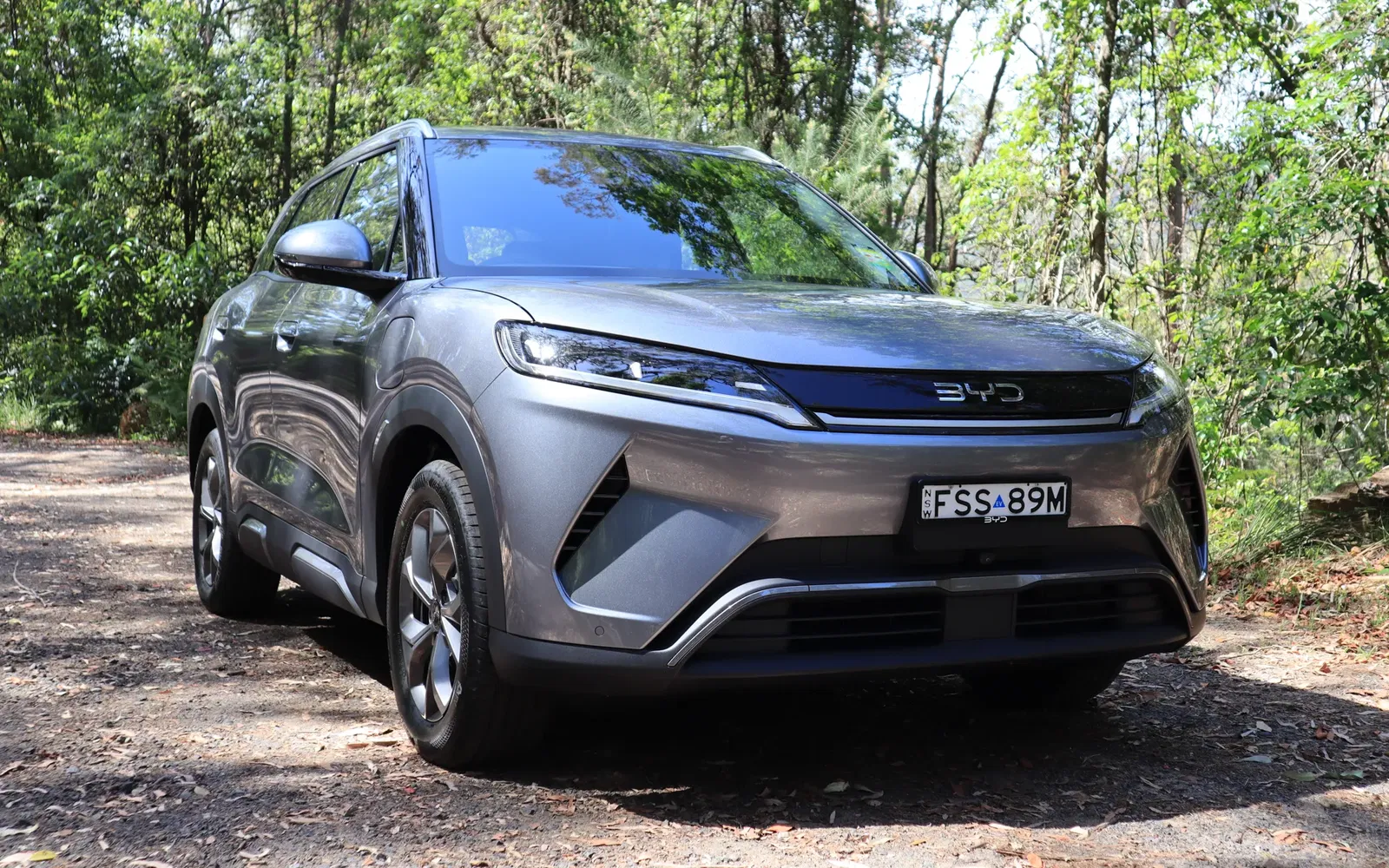%20Calligraphy%20-%2003.webp)
2026 Hyundai Palisade Review
The 2026 Hyundai Palisade has a new look, a hybrid powertrain and a price tag just shy of $90,000 before on-roads. But how does the second-gen version stack up?
A
UNGRADED

A
UNGRADED

What people are saying:
Pros
- Unique exterior design
- Luxurious and spacious interior
- Strong practicality
Cons
- Overly aggressive lane centring
- ADAS settings are buried in the infotainment system
- More expensive than rivals
The 2026 Hyundai Palisade has landed in Australia, marking the arrival of the large, family SUV’s second generation.
From launch, the new version of Hyundai’s more premium family hauler arrives with a new look inside and out, two different seating configuration choices, a new hybrid powertrain, and a price tag a stone’s throw short of $90,000.
As Hyundai’s flagship family SUV, the new Palisade has some equally big boots to fill. So what does the new one bring to the table, and how does it compare to similar family SUV rivals? Time to find out.
%20Calligraphy%20-%2020.webp)
%20Calligraphy%20-%2015.webp)
%20Calligraphy%20-%2044.webp)
How much does the 2026 Hyundai Palisade Cost?
From launch, the 2026 Hyundai Palisade range comprises a single Calligraphy Hybrid variant, with prices starting at $89,900 before on-road costs.
At least from the outset, the Australian Palisade lineup has been slimmed down significantly for the second generation, with the entry-level Elite trim level dropped from the range. Until the arrival of the more rugged, off-road XRT Pro variant in Australia, this is the only Palisade to choose from.
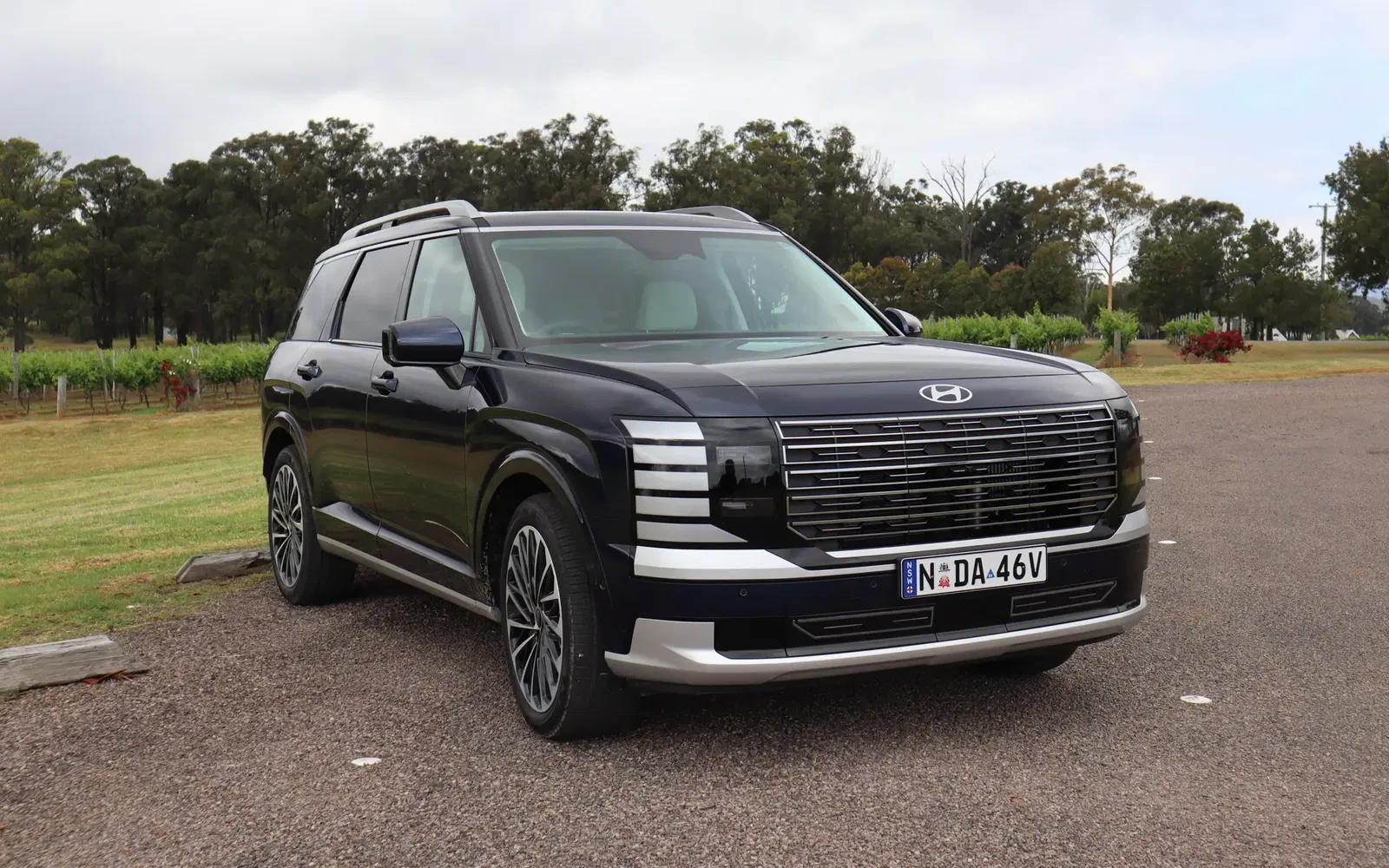
With the diesel and petrol-only variants gone, the Calligraphy has seen a price rise as a result. Prior to its retirement, the first-generation Calligraphy variants were priced at $75,900 before on-road costs for the petrol and $79,990 before on-roads for the diesel.
Compared to large, family SUV rivals, the Palisade is on the pricier side. By the time you get into a Palisade, you’re more than halfway up the Mazda CX-90 ladder, as $86,070 before on-roads will get you a G50e Azami AWD.

It’s also more expensive than the range-topping variants of other family SUVs such as the Nissan Pathfinder TI-L 4x4 ($82,850 before on-roads), the Toyota Kluger Grande AWD Hybrid ($85,790 before on-roads), and the Kia Sorento GT-Line Plug-In Hybrid AWD ($85,790 before on-roads).
There’s no denying that, compared to its rivals, the Palisade is more expensive. Although its pricing doesn’t necessarily render it uncompetitive. It positions itself as a more luxury-oriented offering that bridges the gap between the likes of Kia, Mazda, and Toyota’s offerings and premium large family SUVs from Lexus, BMW, Mercedes-Benz and Audi.
It’s certainly a conscious choice consumers have to make to walk past its Santa Fe stablemate (the range-topping variant of which is some $12,750 cheaper) to choose the Palisade. But its pricing arguably allows it to fulfil a more luxury niche.
2026 Hyundai Palisade Pricing Before On-Road Cost
- Calligraphy Hybrid AWD: $89,900
Options
- Premium Paint: $750
- Dark Charcoal/Brown/Dark Navy & Light Grey Interior: $295
- Seven-seat Layout: $1,000
Modern with Retro Styling Cues
The first-generation Hyundai Palisade, especially post-facelift, was quite an attractive family car, but the new one has a serious wow factor in my opinion.
Its design is headlined by its front end, which is a radical departure from its predecessor. The blocky, silver-coated daytime running lights and its simple yet effective grille design contribute to a unique, clean, and futuristic visual signature.
%20Calligraphy%20-%2005.webp)
At the side, you catch your first glimpse of the taillights – which continue the blocky styling of the DRLs – as they wrap around the Palisade’s rear corner. Its straight, lengthy glasshouse accentuates the wagon look, of which I am personally a fan.
I also feel the use of chrome trim on the D-pillar and along the roof line has given the second-generation Palisade a stronger side profile compared to its predecessor.
%20Calligraphy%20-%2022.webp)
Aside from the taillights, the rear-end design is arguably less exotic than the rest of the new Palisade, but it tastefully caps off its sleek, futuristic, yet tasteful design.
However, as modern as the new Palisade looks, I can’t help but pick up on some retro flair. It seems to bring the boxier SUV wagon designs of the 1970s, ‘80s, '90s into the present day. I see vehicles like the SJ Jeep Grand Wagoneer, third-generation Ford Bronco and even the Range Rover Classic in its simple, squared-off light and grille package, along with its boxy wagon design.
%20Calligraphy%20-%2002.webp)
Intentional or not, the retro cues are cool. But it doesn’t feel like it’s trying to be a modernised nostalgia trip. The new Palisade certainly has its own identity, and a modern, sophisticated and stylish one at that.
Luxury Event
Too often these days, it seems that car cockpit design starts and ends with slapping a massive touchscreen on the dashboard and calling it a day. However, it’s safe to say that this is not the case for the 2026 Hyundai Palisade.
The Palisade’s front row is a brilliantly sculpted visual event. Its rounded design elements, such as the curved fascia, the capsule-shaped centre console, and the oval air conditioning vents and dashboard control panel, certainly set it apart from other cockpits. According to Hyundai, the interior was inspired by luxury furniture, and I can see where they’re coming from.
%20Calligraphy%20-%2043.webp)
The Nappa leather-appointed trim looks and feels excellent, wrapping many of the major touchpoints, adding to the premium experience. Unfortunately, the metallic-looking plastic surfaces, such as the silver piece on the steering wheel, don’t feel quite as expensive, although, as plastic quality goes, I’ve felt far worse.
It’s easy to get comfortable in the Palisade, with 18 ways of electric adjustability for the driver and 12 ways for the passenger, while both front occupants enjoy seat heating and ventilation.
You’ll also find the usual amenities in the front row of the Palisade, including wireless phone charging, three USB-C ports, a 12V socket and two cupholders.
%20Calligraphy%20-%2045.webp)
The only slight gripe from a comfort standpoint is that you can sometimes become aware of the decorative metal pieces embedded in the leather seat on your back. While they aren’t hugely irritating, I still found myself conscious of their presence. Ultimately, I’m nitpicking, though. The cockpit of the Palisade is a very comfortable place to be.
Forward visibility is also strong, with its large windscreen, thin A-pillars, and the side window’s decent view beyond the wing mirrors, which is comforting given the size of the vehicle you’re piloting.
%20Calligraphy%20-%2048.webp)
Overall usability in the Palisades front row is fairly strong, particularly due to its physical controls, including those for media volume, drive modes, and certain infotainment touchscreen navigation options. The Air conditioning and HVAC controls are also pleasant to interact with, with a physical dial for the air temperature and a touchscreen panel dedicated to HVAC functions.
The 12.3-inch infotainment system is crisp and reasonably intuitive, with most key functions easily accessible. Only the customisable ADAS features are genuinely difficult to get to, as these are buried within several sub-menus.
%20Calligraphy%20-%2044.webp)
When it comes to storage, the Palisade holds its own. The cleared-out space between the centre console and the dashboard offers a lot of space. However, because it’s so low to the floor, it isn’t particularly easy to access while on the move, but it’s still useful for storing items that aren’t needed immediately.
The centre console armrest storage – which is UVC-Sterilised – isn’t the deepest I’ve come across, but it’s long enough that it’s still usable. The same can’t be said for the glovebox, which is pretty small.
Overall, the 2026 Hyundai Palisade’s cockpit is a comfortable place to be, with decent levels of practicality and usability. But above all else, the cabin looks and feels genuinely special, an x-factor found in few front rows.
Take Your Pick
In the second row of the Hyundai Palisade, you’ll find either a conventional three-seat bench in the eight-seat version, or – for an additional $1,000 – you’ll find two captain’s chairs, with a pass-through to the rear-most row.
However, regardless of which you pick, the second row offers space, comfort, and a strong list of amenities and storage options.
%20Calligraphy%20-%2046.webp)
Really, the choice comes down to whether or not you need space for eight people and would like to hold onto $1,000, or if you’d like to prioritise personal space and luxury for your second-row passengers, and have easier access to the final row of seats.
Behind my own driving position (5’11”), I had massive knee room and great headroom in the outboard seats in both configurations. Middle-seat passengers in the eight-seater won’t find themselves short-changed either, still enjoying great headroom, and the relatively small transmission tunnel isn’t too intrusive.
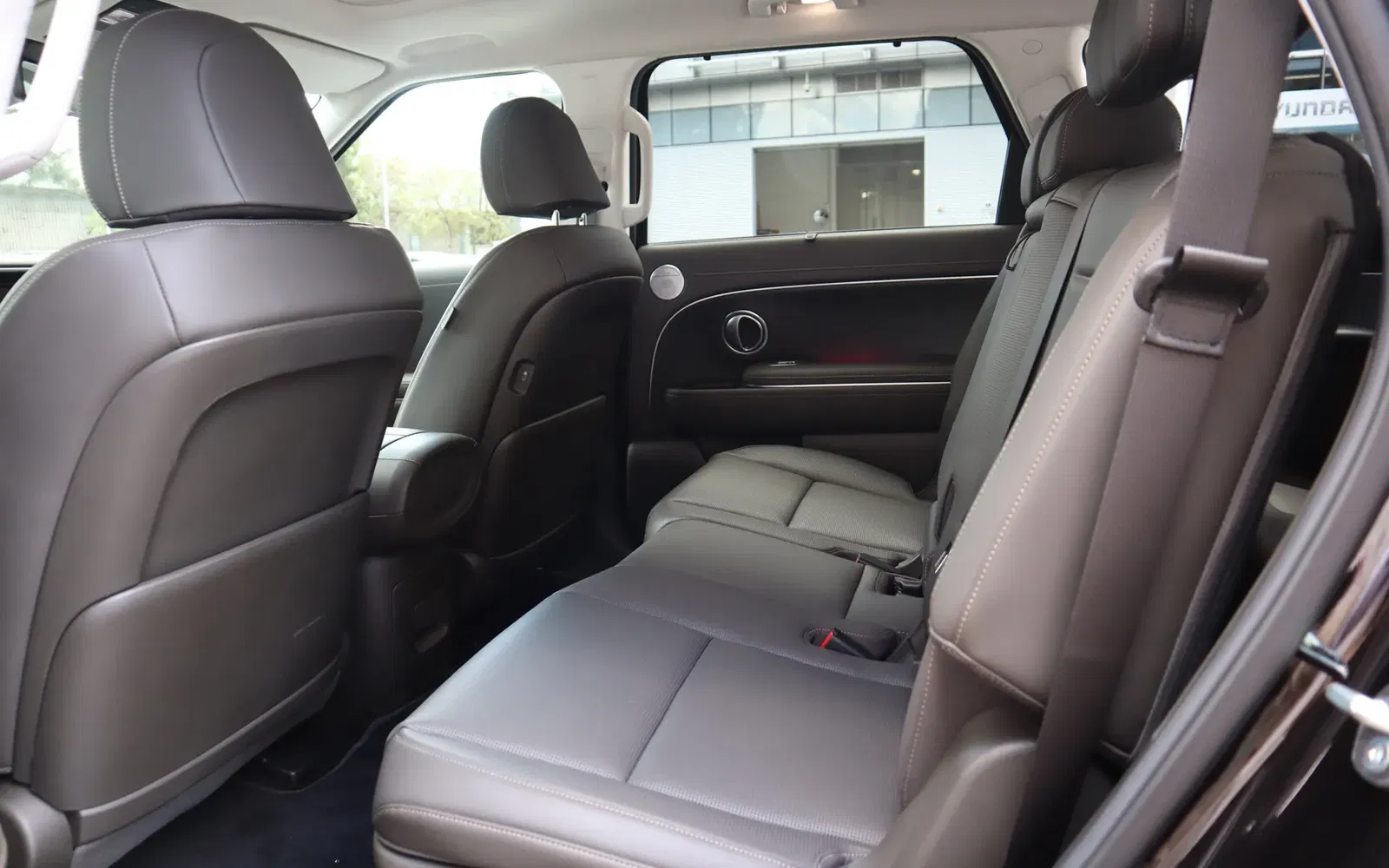
Across both variants, second-row passengers have access to two UBS-C ports, air conditioning controls, heated and ventilated outboard seats, useful cupholders in the doors, large seat pockets behind the front seats, and side window shades.
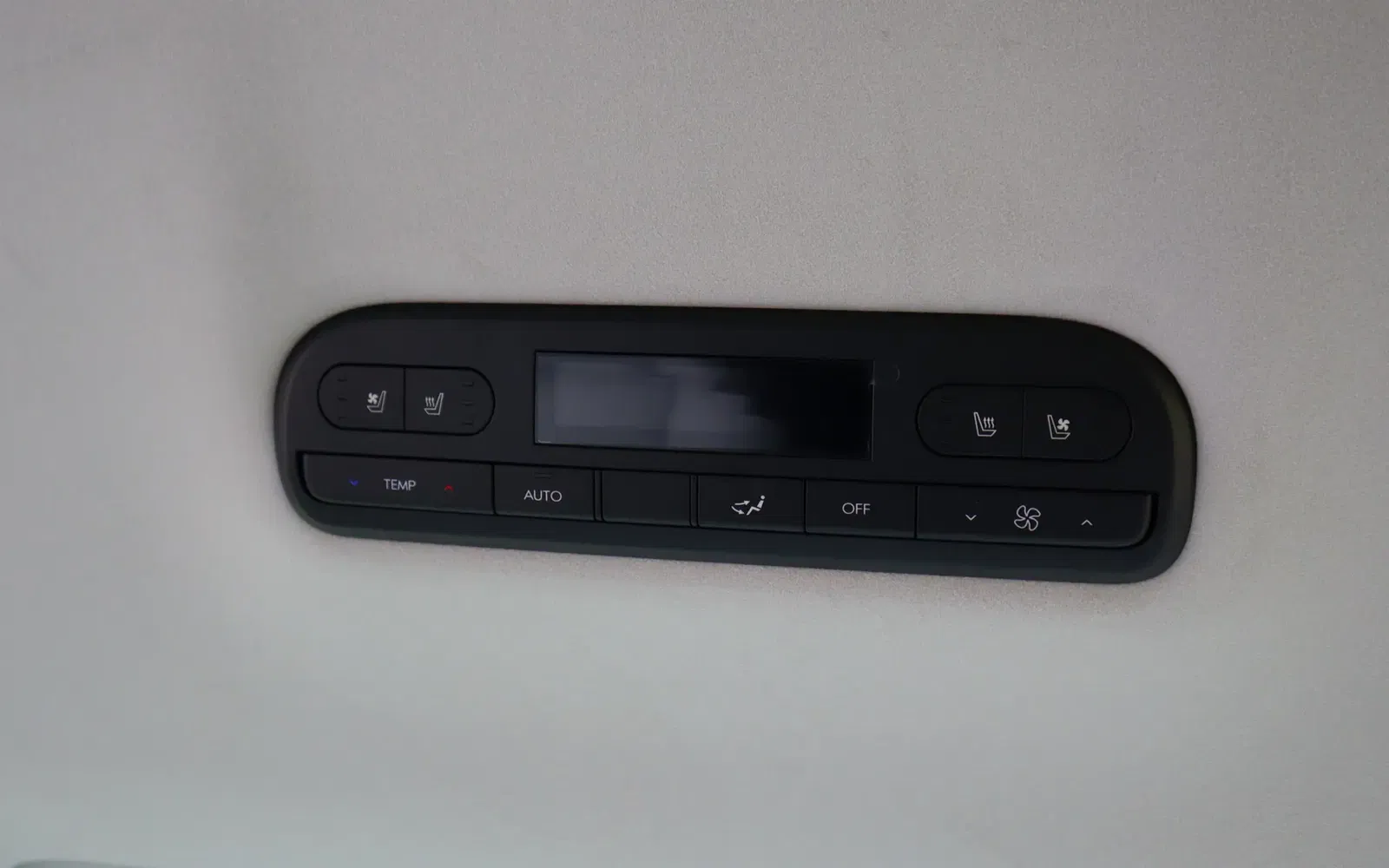
However, some of these amenities aren’t exactly where you’d expect them to be. You’ll find the air conditioning controls and air vents on the ceiling, and the USB-C ports on the sides of the front seats instead of behind the front centre console. Instead, a drawer occupies this space, which is a great place to store smaller items.
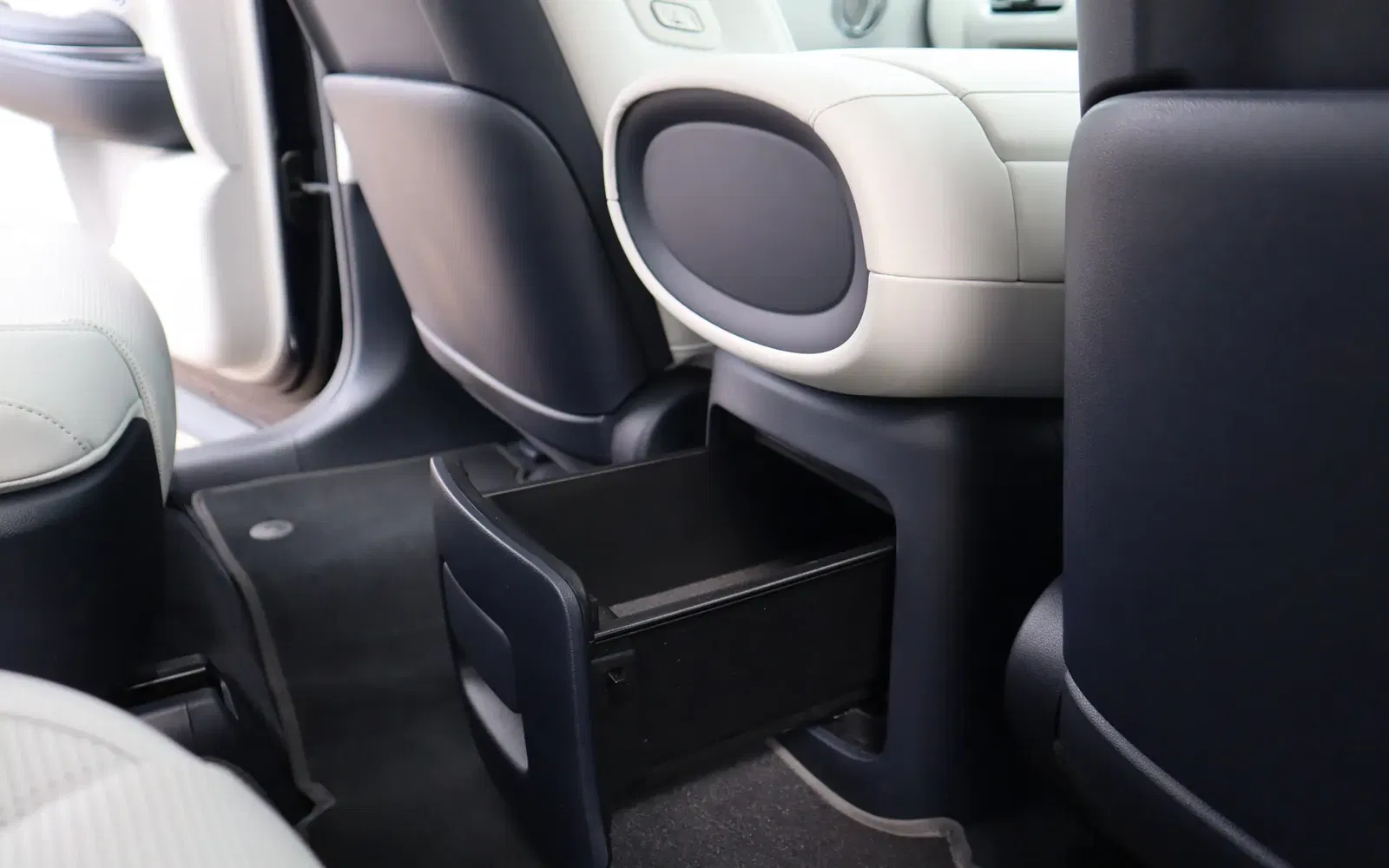
When it comes to differentiating equipment between the eight-seater and the seven-seater, the former gets a centre-folding armrest with cupholders, while the captain’s chairs in the latter get airline-style armrests and the ability to electrically slide and recline.
While the experience of each configuration varies in some ways, whichever option you choose, the 2026 Palisade’s second row feels spacious, practical and well-equipped.

Plenty of Creature Comforts
Third-row passengers have not been forgotten about in the 2026 Hyundai Palisade, also enjoying many of the creature comforts afforded to the second row.
For starters, the seats are electrically adjustable, capable of sliding backwards and forwards as well as reclining. This means that even adults relegated to the Palisade’s stern will be able to create some space for themselves and get comfortable.
%20Calligraphy%20-%2047.webp)
You’ll find USB-C ports, air vents on the ceiling, heated outboard seats, two cupholders on either side, and reading lights in the third row. Considering that there are plenty of vehicles out there that don’t even have these features in the second row, the rearmost seats of the Palisade seem all the more impressive.
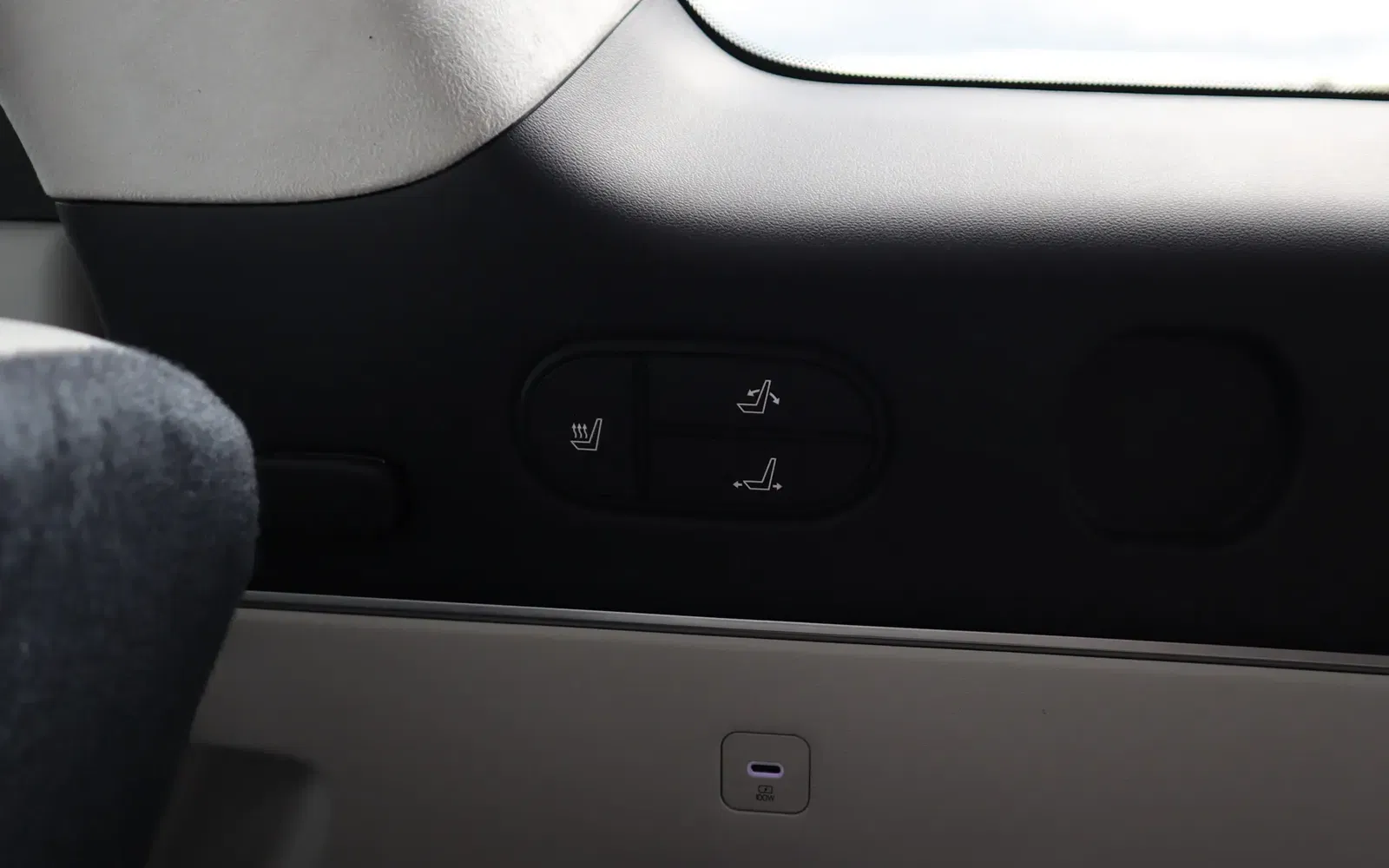
Without question, you’ll be able to seat two passengers – children or adult – in the back of the Palisade. However, while you can technically seat three, I think that’s pretty optimistic, even for kids, as the middle seat is quite narrow.
Overall, the 2026 Hyundai Palisade’s third row is not only usable, but it's also arguably luxurious.
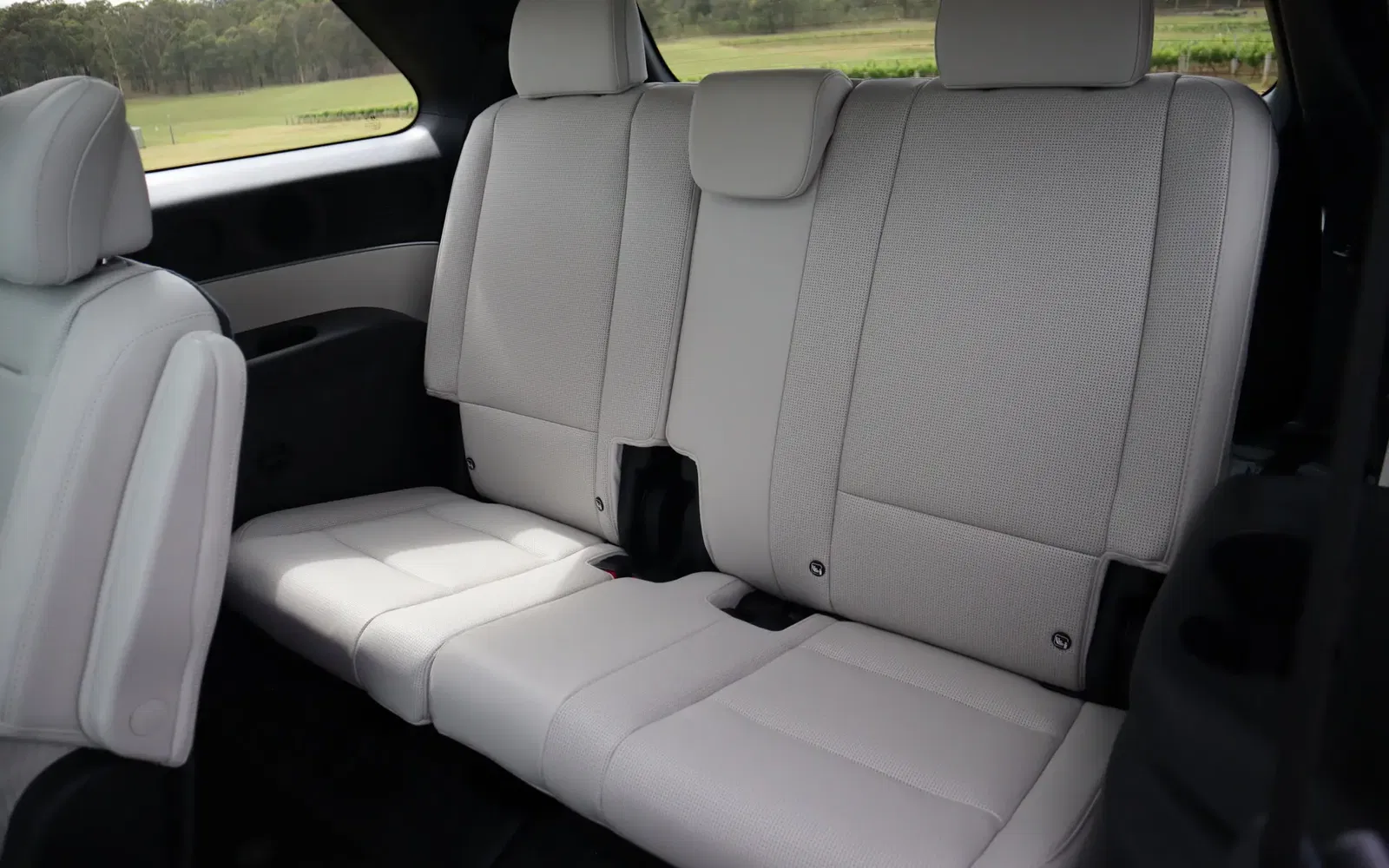
Electric Convenience
The 2026 Hyundai Palisade has 300 litres of boot space with all rows upright, expanding to 712 litres with the rear-most seats dropped and up to 2,081 litres with the second row of seats folded as well.
Based on their respective claimed capacities, the Palisade has more boot space with the third row up, third row folded, and with the second row folded than similar family SUV rivals, such as the Mazda CX-90, Kia Sorento and the Toyota Kluger.
In the boot of the Palisade, you’ll find a control panel on the left-hand side wall to electrically slide and fold the second and third rows of seats. While this isn’t a groundbreaking feature for a large family SUV, it’s still noteworthy for its convenience and is certainly a welcome feature. Also on the wall, you’ll find a 12V socket and the V2L plug.
There’s also a full-size spare wheel, which you’ll find beneath the vehicle at the rear.
The Palisade boasts some extremely impressive practicality, with impressive, outright cargo space and the added convenience of being able to electrically control the second and third rows at the touch of a button.
%20Calligraphy%20-%2059.webp)
%20Calligraphy%20-%2060.webp)
%20Calligraphy%20-%2061.webp)
%20Calligraphy%20-%2053.webp)
It’s Got Grunt
The 2026 Hyundai Palisade is powered by a 2.5-litre turbocharged four-cylinder petrol engine and dual electric motors, mated to a six-speed automatic transmission. It has a combined system output of 245kW and 460Nm.
Compared to its hybrid rivals, it has more power than the Toyota Kluger (184kW) and more power and torque than the Kia Sorento (169kW/350Nm).
%20Calligraphy%20-%2067.webp)
Claimed combined fuel economy is 6.8 litres per 100 kilometres. A lot of my time with the Palisade was spent on motorways and fast country roads, during which the trip computer generally posted numbers between 8.2 and 9.3 litres per 100 kilometres. But on my final drive, which saw a combination of both urban and motorway driving, it achieved 6.6 litres per 100km.
%20Calligraphy%20-%2038.webp)
Compared to other hybrid family SUVs, these aren’t standout numbers. The Kluger hybrid and Sorento Hybrid AWD have claimed consumptions of 5.6 litres and 5.7 litres per 100 kilometres, respectively.
Overall, what it lacks compared to some rivals when it comes to fuel economy, the 2026 Hyundai Palisade makes up for it with grunt.
Seamless System
The 2026 Hyundai Palisade’s hybrid system sources electricity from a 1.65kW/h battery. While on the move, the system seamlessly switches between Hybrid, EV, Series and Regenerative Braking modes.
Hybrid mode uses power from both the internal combustion engine and the electric motors in tandem to drive the wheels at the same time, while EV mode uses electric power only while moving at low speeds or while coasting.
%20Calligraphy%20-%2056.webp)
Series mode uses the internal combustion engine to recharge the battery, while Regenerative Braking mode, as its name suggests, recharges the battery through regen braking.
Beyond switching between modes, the hybrid system supports 3.6kW Vehicle-to-Load (V2L) functionality and has a ‘Stay Mode’ function that uses the hybrid battery to power the infotainment system while the engine is off and the vehicle is stationary.
Comfort Done Right
When first setting off in the 2026 Hyundai Palisade in an urban environment, it feels big. Really big. And that’s because it is. Measuring 5,065mm long, 1,980mm wide, 1,805mm tall, and with a wheelbase of 2,970mm, this is no compact runabout. Lanes certainly feel smaller behind the wheel of the Palisade, and vehicles next to you feel a little closer than you’d normally expect.
Some drivers might appreciate the tank-like security that its size provides. The feeling that you might fare better should a bus, truck or apartment building try to share the same real estate as you may be comforting to some. But it’s definitely an adjustment.
Thankfully, piloting the Palisade is made a little easier thanks to its strong forward visibility and safety features such as the Blind-Spot View Monitor, which displays rear-facing side views on the digital instrument cluster.
%20Calligraphy%20-%2038.webp)
The motorway is where the Palisade really comes into its own. Turn on Highway Driving Assist – which uses the Smart Cruise Control, Lane Centring, and the Lane Change Assist systems – and cruising becomes a breeze as the Palisade covers kilometres with little effort from its driver. Road, wind and tyre noise are also kept to a minimum, even at higher speeds.
Turn off onto a typical Australian country road, and when the surface quality decreases, the Palisade takes it in its stride. The ride is soft without feeling squidgy or taking too long to settle. You’ll find yourself aware of certain surface inconsistencies, mainly when hitting small bumps in quick succession, but it’s pretty far from crashy and the furthest thing from unpleasant. Even when the roads turn to gravel, while again, you’re still aware of the surface quality beneath you, the Palisade remains perfectly comfortable.
%20Calligraphy%20-%2041.webp)
Tuck into a corner, and you certainly feel the Palisade’s weight shift and the body roll slightly. However, while it’s not a sports car or necessarily the most fun to drive, it still corners confidently.
The steering feels slightly thick on-centre but lighter while turning, and while Sport mode ups the on-centre weight, it’s always on the lighter side. There’s a little bit of road texture feedback, but it’s not the most communicative of steering.
As for the powertrain, for the most part, it works away quietly, but put your foot down and it delivers a reasonably potent punch. While this certainly isn’t a performance engine, it feels appropriate for the vehicle, and certainly never underpowered.
%20Calligraphy%20-%2039.webp)
When it comes to ADAS tuning, while I’ve mentioned the strengths of Highway Driving Assist and Blind-Spot View monitor, I found the Lane Centring tuning slightly too aggressive, especially on country roads, often feeling overly firm, making smaller steering inputs feel a little awkward. You can override the system with sufficient torque, but this sensation detracts from an otherwise extremely refined experience.
ADAS aside, the Palisade’s driving experience feels certain of its identity. It doesn’t feel particularly sporting, but at no point does it ever try to be. It’s tuned to be a comfortable, quiet, easy-going family SUV and focuses its efforts completely on achieving that objective.
As a result, it's particularly adept at being a long-distance cruiser, making monotonous journeys quite pleasant, and when the roads get rougher, it’ll handle that too. The Palisade clearly set out with a clear experiential objective and achieves it convincingly.
Waiting on ANCAP Score
As of November 2025, the 2026 Hyundai Palisade is currently undergoing ANCAP testing. While we won’t know its scores until the end of the year, Hyundai are targeting a five-star ANCAP rating.
The centre lamp across the grille – featured on the Palisade examples in the Korean and North American markets – has been deleted for the Australian version for the sake of pedestrian safety, a measure taken in the pursuit of five stars.
%20Calligraphy%20-%2027.webp)
While ADAS systems like Highway Driving Assist are useful and well-calibrated, I found the Lane Centring a bit too aggressive. The safety systems are customisable, although because it’s buried within layers of the infotainment system, it’s not the easiest to adjust, especially on the move.
In any case, the 2026 Hyundai Palisade comes loaded with safety features, including:
- Blind-spot view monitor
- Blind-spot Collision Avoidance
- In Cabin Camera
- Parking Distance Warning
- Parking Collision Avoidance
- Highway Driving Assist
- Forward Collision Avoidance
- Speed Limit Assist
- Lane Following Assist
- Lane Keep Assist
- Manual Speed Limit Assist
- Rear Occupant Alert
- Surround View Monitor
- Navigation-based Adaptive Cruise Control
- Tyre-pressure monitoring
- Eight airbags
Relative Reasonable
The 2026 Hyundai Palisade comes with a seven-year/unlimited kilometre warranty – provided all services are completed by an authorised Hyundai dealer and in accordance with the service intervals – as well as an eight-year/160,000km battery warranty.
Lifetime roadside assist is also offered for the Palisade, although, like the seven-year warranty, this is also dependent on the vehicle being serviced with Hyundai. Essentially, 12 months of roadside assist is offered by default, with an additional 12 months added with each service.
%20Calligraphy%20-%2017.webp)
The Palisade comes with a five-year servicing plan, with servicing intervals every year of 10,000km. Prices for each service range between $397 and $674, coming to a total of $2,600 over five years.
While its fuel economy isn’t necessarily class-leading among large hybrid family SUVs, the Palisade’s hybrid powertrain will save you at least some cash on fuel compared to non-hybrid offerings (although it may take some time to break even on the initial purchase price). It’s also compatible with both 91 RON and E10 fuel, unlike some rivals.
%20Calligraphy%20-%2025.webp)
Once clearing the relatively high initial barrier of entry, the ownership costs of the 2026 Hyundai Palisade are fairly reasonable.
What do you get with the 2026 Hyundai Palisade?
Standard features on the 2026 Hyundai Palisade Calligraphy Hybrid Include:
- 21-inch alloy wheels
- 12.3-inch infotainment display
- 12.3-inch digital instrument cluster
- 14-speaker Bose premium sound system
- Welcome and escort lights
- Power sunroof
- LED headlights, tail lights and back-up lights
- Privacy Glass
- Roof Rails
- Rear camera sensor cleaning
- Nappa leather interior w/ suede roof lining
- Leather steering wheel
- LED room lamps
- 18-way electrically adjustable driver’s seat w/ memory
- 12-way electrically adjustable passenger’s seat
- Electrically adjustable third row seats
- Second-row captain's chairs (seven-seat option)
- Electrically adjustable second row seats (seven-seat option)
- Heated steering wheel
- Heated outboard seats (all rows)
- Ventilated outboard seats (front and second-row)
- USB-C ports (x6)
- Wireless charging
- Digital Key
- Fingerprint recognition
- Vehicle-to-Load (V2L)
- “Stay” mode
- Auto-folding third-row headrests
- Auto up/down windows
- Smart key w/ push button start
- Rain-sensing wipers
- Digital Centre Mirrors
- Heads-up display
- Full-size spare wheel
- Blind-spot view monitor
- Blind-spot Collision Avoidance
- In Cabin Camera
- Parking Distance Warning
- Parking Collision Avoidance
- Highway Driving Assist
- Forward Collision Avoidance
- Speed Limit Assist
- Lane Following Assist
- Lane Keep Assist
- Manual Speed Limit Assist
- Rear Occupant Alert
- Surround View Monitor
- Navigation-based Adaptive Cruise Control
- Tyre-pressure monitoring
- Eight airbags
Final Thoughts
The 2026 Hyundai Palisade Calligraphy Hybrid offers unique exterior styling, a luxurious, well-equipped interior, an immensely comfortable driving experience, strong practicality, a long list of safety features, and a decent ownership package.
%20Calligraphy%20-%2029.webp)
While the Palisade certainly isn’t the cheapest compared to hybrid family SUV rivals (from launch at least) or the most fuel efficient, has slightly too aggressive Lane Centring that can’t easily be turned off, and certainly feels its size and weight, it’s an immensely attractive package. Even at $89,900 before on-roads, the Palisade still feels like it's punching above its weight.
If you’re in the market for a family SUV with a premium feel but don’t want to spend north of $100,000, the 2026 Hyundai Palisade is a compelling, well-sorted choice, and should certainly be on your radar.
Saucey rating breakdown
Saucey rating breakdown
FAQ
Sign up to our newsletter
Be the first to know when we drop new car reviews.
.avif)



